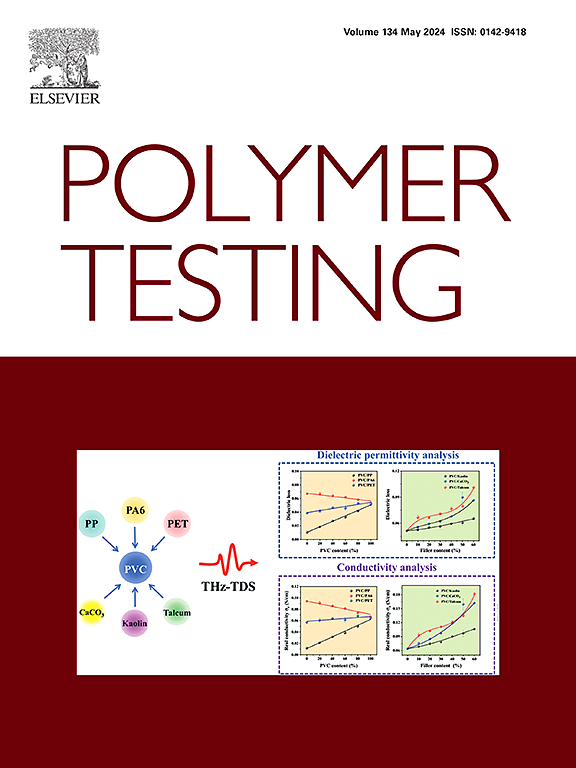A cost-effective protocol for detecting fluorescent microplastics in arable soils to study redistribution processes
IF 6
2区 材料科学
Q1 MATERIALS SCIENCE, CHARACTERIZATION & TESTING
引用次数: 0
Abstract
Understanding microplastics' (MPs) transport from soils to aquatic ecosystems is challenging due to labor-intensive detection methods, especially in large-scale plot experiments analyzing surface runoff and soil erosion. To address this, we used fluorescent MPs as tracers and developed a cost-effective protocol to detect them in dry soils and eroded sediments. We analyzed spherical polyethylene (PE: 125–150 μm; 425–500 μm) and irregular polylactic acid (PLA: 125–150 μm; 250–300 μm). Sample assays were prepared primarily based on dry and wet sieving. Subsequent darkroom photography under 365 nm illumination, and thresholding and segmentation-based image analysis were done. The developed protocol demonstrates high reliability, precision, and F-scores of 88.7 % ± 2.9 %, 85.2 % ± 3.1 %, and 86.9 % ± 2.8 %. PE exhibited slightly higher recovery rates (85 % ± 5 %) than PLA (79 % ± 8 %). Particle size influenced recovery, with larger MPs achieving significantly higher recovery. Smaller particles showed slightly lower recovery under dry soil conditions, but their recovery improved under sediment conditions facilitated by wet sieving and ultrasonication. All fluorescent MPs retained >95 % detectability after three months of storage, highlighting marker temporal stability. Compared to existing methods, this protocol eliminates complex digestion steps, reduces costs, and ensures minimal contamination, providing a robust framework for MP transport studies. It offers potential for enhancement through advanced imaging and machine learning, enabling more efficient and accessible detection in environmental research.
一种具有成本效益的检测可耕种土壤中荧光微塑料以研究再分配过程的方案
了解微塑料(MPs)从土壤到水生生态系统的运输是具有挑战性的,因为劳动密集型的检测方法,特别是在分析地表径流和土壤侵蚀的大规模小区实验中。为了解决这个问题,我们使用荧光MPs作为示踪剂,并开发了一种具有成本效益的方案来检测干燥土壤和侵蚀沉积物中的MPs。我们分析了球形聚乙烯(PE: 125-150 μm;425 ~ 500 μm)和不规则聚乳酸(PLA: 125 ~ 150 μm;250 - 300μm)。样品分析主要基于干法和湿法筛分。随后在365 nm照明下进行暗室摄影,并进行阈值分割和基于分割的图像分析。该方案具有较高的可靠性和精确性,f评分分别为88.7%±2.9%、85.2%±3.1%和86.9%±2.8%。PE的回收率(85%±5%)略高于PLA(79%±8%)。颗粒大小影响回收率,更大的MPs实现更高的回收率。在干燥土壤条件下,较小颗粒的回收率略低,但在湿筛和超声波的促进下,其回收率有所提高。所有荧光MPs在储存三个月后仍保持95%的可检测性,突出了标记的时间稳定性。与现有方法相比,该方案消除了复杂的消化步骤,降低了成本,并确保了最小的污染,为MP运输研究提供了一个强大的框架。它通过先进的成像和机器学习提供了增强的潜力,从而在环境研究中实现更有效和更容易的检测。
本文章由计算机程序翻译,如有差异,请以英文原文为准。
求助全文
约1分钟内获得全文
求助全文
来源期刊

Polymer Testing
工程技术-材料科学:表征与测试
CiteScore
10.70
自引率
5.90%
发文量
328
审稿时长
44 days
期刊介绍:
Polymer Testing focuses on the testing, analysis and characterization of polymer materials, including both synthetic and natural or biobased polymers. Novel testing methods and the testing of novel polymeric materials in bulk, solution and dispersion is covered. In addition, we welcome the submission of the testing of polymeric materials for a wide range of applications and industrial products as well as nanoscale characterization.
The scope includes but is not limited to the following main topics:
Novel testing methods and Chemical analysis
• mechanical, thermal, electrical, chemical, imaging, spectroscopy, scattering and rheology
Physical properties and behaviour of novel polymer systems
• nanoscale properties, morphology, transport properties
Degradation and recycling of polymeric materials when combined with novel testing or characterization methods
• degradation, biodegradation, ageing and fire retardancy
Modelling and Simulation work will be only considered when it is linked to new or previously published experimental results.
 求助内容:
求助内容: 应助结果提醒方式:
应助结果提醒方式:


